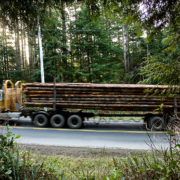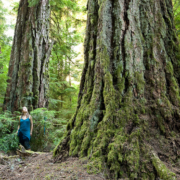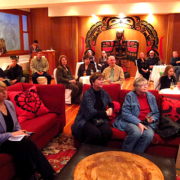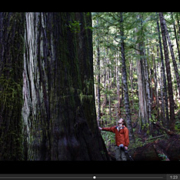Translation needed in raw-log export debate
/in News Coverage/by TJ WattI’m thinking the public may need some interpretation on this treatise defending raw log exports in the Times Colonist [article not available anymore].
The three authors, all logging industry executives, are speaking logspeak, a language that may be confused with English.
They say: Raw log exports “make some stands of timber economically viable which previously would have been left standing.”
The translation: “Raw log exports allow us to liquidate forests for quick profit without regard for future potential.”
They say: These logs “cannot be processed in the company’s mills.” The translation: “We haven’t invested in our mills to be competitive with international markets, nor do we have any impetus to do so if we can continue to make quick money with no need for investment through raw log exports.”
They say: A log export panel approves raw log exports “based on a surplus test.” The translation: “This doesn’t include private forestry land, which composes the bottom third of Vancouver Island and most of Vancouver Island’s best forests, which can be exported without restriction and composes the bulk of the trees being loaded into freighters every week. But we won’t mention that because it kills the point we were trying to make.”
They say: “In WFP’s case, our exports allow 1.5 million cubic metres to be harvested that would not otherwise be economically viable.” The translation: “BC’s forest industry isn’t in complete cardiac arrest, so be thankful for the little you have left.”
They say: “The company ran 23 per cent more shifts at its Island mills in the first quarter of this year than in 2010.” The translation: “We bottomed out in the first quarter of 2010, and if we can link an unrelated upswing to make our case for raw log exports we will do so.”
They say: “Banning log exports from BC would transfer economic wealth and jobs to these other exporting countries.” The translation: “We will justify our inefficiency because international markets are forcing a downward spiral, which we can use to leverage less oversight of our industry.”
If you feel a bit like the three authors read you a bedtime story, patted you on the head and tucked you in, you’re not alone.
But I’m still a bit lost on the story’s ending, which doesn’t ring true.
Here’s the reason. Every time I hear a logging company representative tell me it’s in the public’s best interest that we liquidate our forests inefficiently, I tend to think they’re confusing the public’s best interest with their own.
For instance, as a shareholder in Crown forests (as all Canadians are), I’d like to see our public forests managed for sustainability, value-added job potential, affordable domestic use and recreational values with profits to support education, health care and other social needs. I suspect those are very far removed from the values reflected by the writers and the shareholders of the companies they represent.
They say: “Certainly the current policy and system can be improved.” The translation (loosely interpreted): “We’d like fewer restrictions on exporting logs.”
What it should mean: “BC’s forests are a valuable public resource that should be managed with public ideals in mind.”
Apologies that my logspeak is a bit rusty, as I don’t think there’s a term in logspeak for “public ideals.”
John Kimantas is the editor of Wavelength magazine and author of The Wild Coast.








